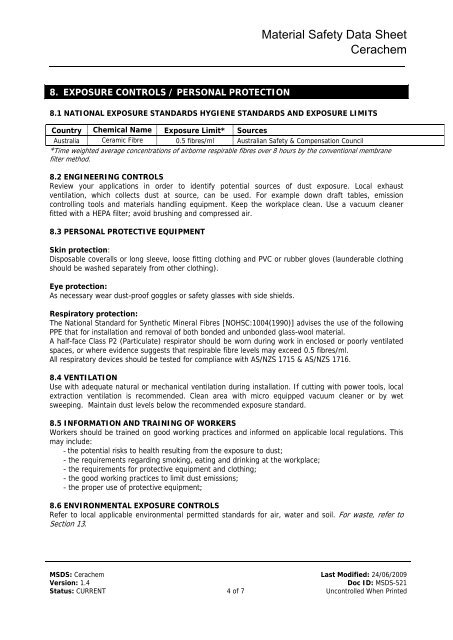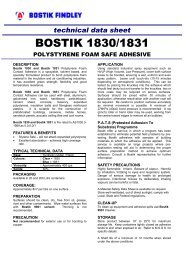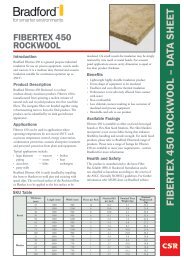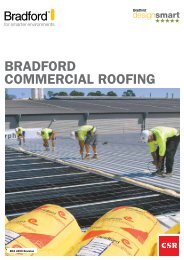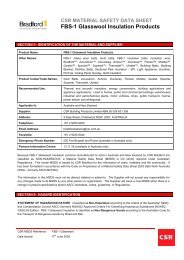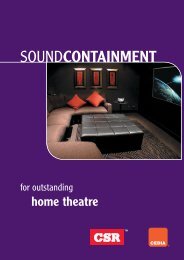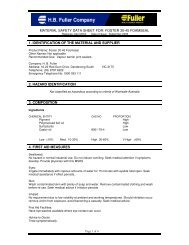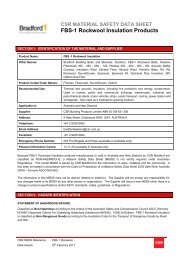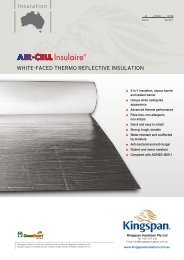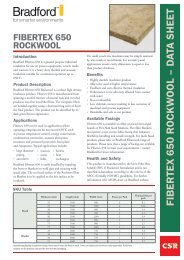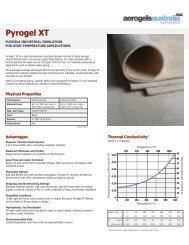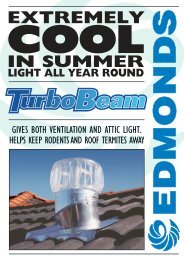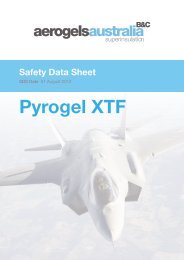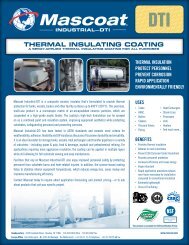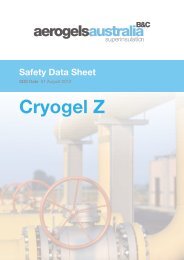9015_MSDS - Cerachem.pdf - Insulation Industries
9015_MSDS - Cerachem.pdf - Insulation Industries
9015_MSDS - Cerachem.pdf - Insulation Industries
Create successful ePaper yourself
Turn your PDF publications into a flip-book with our unique Google optimized e-Paper software.
Material Safety Data Sheet<br />
<strong>Cerachem</strong><br />
8. EXPOSURE CONTROLS / PERSONAL PROTECTION<br />
8.1 NATIONAL EXPOSURE STANDARDS HYGIENE STANDARDS AND EXPOSURE LIMITS<br />
Country Chemical Name Exposure Limit* Sources<br />
Australia Ceramic Fibre 0.5 fibres/ml Australian Safety & Compensation Council<br />
*Time weighted average concentrations of airborne respirable fibres over 8 hours by the conventional membrane<br />
filter method.<br />
8.2 ENGINEERING CONTROLS<br />
Review your applications in order to identify potential sources of dust exposure. Local exhaust<br />
ventilation, which collects dust at source, can be used. For example down draft tables, emission<br />
controlling tools and materials handling equipment. Keep the workplace clean. Use a vacuum cleaner<br />
fitted with a HEPA filter; avoid brushing and compressed air.<br />
8.3 PERSONAL PROTECTIVE EQUIPMENT<br />
Skin protection:<br />
Disposable coveralls or long sleeve, loose fitting clothing and PVC or rubber gloves (launderable clothing<br />
should be washed separately from other clothing).<br />
Eye protection:<br />
As necessary wear dust-proof goggles or safety glasses with side shields.<br />
Respiratory protection:<br />
The National Standard for Synthetic Mineral Fibres [NOHSC:1004(1990)] advises the use of the following<br />
PPE that for installation and removal of both bonded and unbonded glass-wool material.<br />
A half-face Class P2 (Particulate) respirator should be worn during work in enclosed or poorly ventilated<br />
spaces, or where evidence suggests that respirable fibre levels may exceed 0.5 fibres/ml.<br />
All respiratory devices should be tested for compliance with AS/NZS 1715 & AS/NZS 1716.<br />
8.4 VENTILATION<br />
Use with adequate natural or mechanical ventilation during installation. If cutting with power tools, local<br />
extraction ventilation is recommended. Clean area with micro equipped vacuum cleaner or by wet<br />
sweeping. Maintain dust levels below the recommended exposure standard.<br />
8.5 INFORMATION AND TRAINING OF WORKERS<br />
Workers should be trained on good working practices and informed on applicable local regulations. This<br />
may include:<br />
- the potential risks to health resulting from the exposure to dust;<br />
- the requirements regarding smoking, eating and drinking at the workplace;<br />
- the requirements for protective equipment and clothing;<br />
- the good working practices to limit dust emissions;<br />
- the proper use of protective equipment;<br />
8.6 ENVIRONMENTAL EXPOSURE CONTROLS<br />
Refer to local applicable environmental permitted standards for air, water and soil. For waste, refer to<br />
Section 13.<br />
<strong>MSDS</strong>: <strong>Cerachem</strong> Last Modified: 24/06/2009<br />
Version: 1.4<br />
Doc ID: <strong>MSDS</strong>-521<br />
Status: CURRENT 4 of 7 Uncontrolled When Printed


